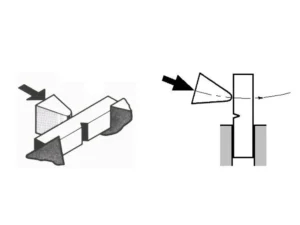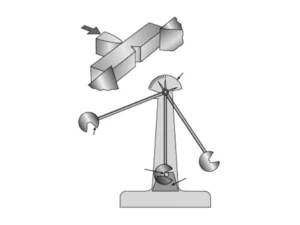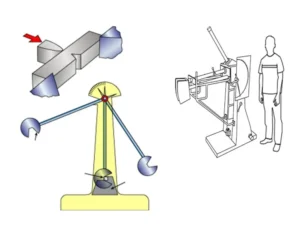Introduction
Have you ever wondered about the strength of metal or plastic? A hard material has more power to sustain a heavy blow. It is another name for the impact resistance. It means that the power of the material to maintain its shape despite the heavy blow is the impact resistance. Various methods evaluate the strength of any material. But we will discuss here the top two—Izod and Charpy. Which one should you use? Don’t worry; we will discuss both and set up a head-to-head comparison of the Izod vs. Charpy impact test.
What is the Izod Impact Test?

In the early 20th century, Edwin Gilbert Izod invented a standard for impact resistance based on the force application mechanisms. An apparatus similar to the Charpy test is reliable in the derivation of values of energy and power for the calculation of impact resistance.
The only difference is the material type, position, and direction of the force applications.
How is this test performed?
Place the metal vertically on the surface. The notch must be on the same side, and the force must be on the upper Tip of the material. A weighted pendulum is also a good choice. Otherwise, you can deploy a farming hammer too.
How is impact resistance calculated?
The force measurements at which fracture occurs define the metal’s hardness. Higher force means a high toughness and vice versa.
What is the Charpy Impact Test?

The Charpy impact test is a widely known test famous for its accuracy in measuring metallic and plastic materials. SB Russell and George Charpy introduced this in the 20th century to measure the strength of the material.
How is this test performed?
It comprises a weighted pendulum that is dropped on the material. Once the pendulum falls on the material, it creates high-impact energy, transferring it to the material. Depending on the material’s impact resistance, such a high force can either deform or keep the material in its original form.
How is the impact resistance calculated?
To infer the exact energy values, you need to measure the height. You can measure it before and after the pendulum strikes the metal. This helps derive the exact values for the material’s impact resistance.
Izod Vs. Charpy: Differences you should know!

Izod vs. Charpy can be an excellent comparison because both tests are top-notch, accurate, and provide many benefits to users regarding values.
You might also wonder which one you should consider. Is that so? Then, check out the following differences between the Izod and Charpy impact tests!
| Features | Charpy Impact Test | Izod Impact Test |
| Material Types | All metals, plastics, and composites | Metals, plastics, and composites |
| Notch Types | U and V-shaped notch | Only V-shaped notch |
| Material Position | Horizontal | Vertical |
| Striking Point | Middle of material | The upper Tip of the material |
| Material Dimensions | 55 x 10 x 10mm | 64 x 12.7 x 3.2mm for plastic
127 x 11.43mm round bar for metal |
| Specifications | 1. ASTM E23, ISO148, ASTM A370 for Metals
2. ASTM D6110 and ISO 179 for plastics |
1. ASTM E23, BS 131 for Metals
2. ASTM D256 and ISO 180 for plastics |
| Hammer Type | Ball-pin Hammer | Farming Hammer |
-
Material Tested
Impact testing is not always on the metals. It can be on any material, which can be either solid or semi-solid. The exact inference of the results depends on the type of material you tested. For example, plastic has less strength compared to stainless steel. So, it all depends on what material you are testing. Both tests offer support for various materials.
In the Izod test, you can test the metals quite efficiently. Other materials used are plastics and composites. The results are quite reliable for the given metals or plastics. Plus, if you ensure the accuracy in the testing process, you can improve the results also.
The Charpy test can be used to test almost all materials, including metallic or plastic ones. It is also suitable for composite materials, offering ultimate ease.
-
Notch Types
Every material must have a notch for focused energy transfer and better testing of the metal’s strength. The notch does not need to be either V-shaped or U-shaped. Depending on the metal’s hardness, it can also be keyholes.
In the Izod test, the notch is only V-shaped. Such notches are helpful for materials with impressive toughness.
In the Charpy test, you can expect two types of notches. One is the U-shaped notch, which is suitable for brittle materials to know their brittleness. On the other hand, a V-shaped notch offers the value for excellent impact-resistance materials.
-
Specimen Position
The material position has a significant influence on power transmission and fracture. For instance, if you plan material in the horizontal direction, it might have a lower horizontal thickness than the vertical. The opposite can occur for some metals, too, depending on their manufacturing aspects.
In Izod testing, the material is kept in a vertical position. A force is applied in the horizontal direction to break the material into pieces and measure the force at which the material breaks down into pieces.
In contrast, the Charpy test has a different position. The material position is horizontal while the force is vertical, allowing a perfect combination of direction and impact. It exerts a significant force on the metal, also allowing quick breaks!
-
Striking Point
Applying force at the corners is useless. The use of a notch helps concentrate the energy and define the strength. Therefore, you should create a notch in the middle or wherever you want to apply your force precisely at the opposite point. Let’s check how both tests react in this case.
Izod impact test creates a V-shaped notch at the middle of the metal or a slight low point in the middle. The horizontal force applies on the upper tip to break the material and concentrate the force at the notch point. Remember one thing here— notch and force applications on the same material aspect.
The charpy impact test is quite different because the notch is on the opposite side. The material is stabilized on the surface notch facing downward. A vertical force acts on the opposite surface. It breaks the material and helps determine the hardness of the material.
-
Specimen Dimensions
Subject dimensions are a decisive factor in determining the material and impact resistance. Moreover, both tests settle at different shapes, directions, and impact force applications. Therefore, material dimensions can assist you in differentiating them.
The IZOD impact test requires different dimensions based on the material you use. For example, you need 64 x 12.7 x 3.2mm for plastic. On the other hand, 127 x 11.43mm is the dimension for a round metal bar. Even if the same material is used, the dimensions remain different. For example, you need 75 x 10 x 10mm for the same material that Charpy test deploys the 55 x 10 x 10mm.
The Charpy test also differs because of horizontal position, different notch shapes, and force applications. You need a proper dimension of 55 x 10 x 10mm for all your materials. Whether plastic or metal, dimensions remain the same throughout the testing process.
-
Common Specs
Different standards define the testing range of the material. Usually, the ISO standards are world-recognized for their testing accuracy. However, in this process, you can also use the ASTM standards.
The IZOD test deploys the different standards for plastic and metals.
- ASTM E23, BS 131 for Metals
- ASTM D256 and ISO 180 for plastics
On the other hand, expect a different range of standards for the Charpy test also.
- ASTM E23, ISO148, and ASTM A370 for Metals
- ASTM D6110 and ISO 179 for plastics
Based on these standards, you can differentiate the metals and plastics tested by each method.
-
Hammer Type
A hammer is the striking material you need to use to measure the toughness. There are two types of hammers— farming hammers and ball-pin hammers.
A farming hammer is the preferred choice for the IZOD test. On the other hand, a ball-pin hammer is a suitable option for the Charpy test.
Which impact tester should you use?
This question is not straightforward because you need to under the following factors.
- Material type and resistance
- Strength of the Material
- Size of the sample
- Do you want a test with basic information or detailed data?
All these factors can help choose the best option among both tests. Moreover, test varies based on the plastic or metal uses. You can also test the material’s brittleness by applying sufficient force that breaks the metal into different pieces.
Conclusion
Whether implementing the Izod or Charpy impact test, confirm the accuracy of your measurements. Eliminate all the flaws in your system, whether human errors or instrumental. We have some top impact machines to keep you at ease with accurate results for impact testing.
OTS Technik is one of the top suppliers of all types of testing equipment. Years of experience, popularity, and adherence to ISO standards make them number one in the town. Whether you need a Charpy impact test machine or Izod, fetch them all now. Check top machines right away!